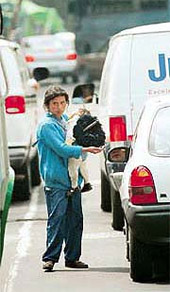 |
 |
 |
 News Around the Republic of Mexico | June 2005 News Around the Republic of Mexico | June 2005  
Poverty Rate Fell Over Last Two Years
 Julián Sánchez - El Universal Julián Sánchez - El Universal


| | A woman holding a child dodges traffic as she begs for pesos on a busy Mexico City street. |
According to a new study authorized by the Social Development Secretariat (Sedesol), the number of people living in poverty in Mexico declined by 3.5 million between 2002 and 2004.

That meant that the nation's poverty rate was reduced from 43 percent to 39.6 percent in the two-year period.

The definition of poverty used in the study was a monthly income of less than 1,487 pesos (US137) for urban dwellers and 1,000 pesos (US92) for inhabitants of rural areas. The definitions used were consistent with international standards, said Sedesol.

However, one member of Sedesol's Technical Committee for the Measurement of Poverty noted that while rural poverty rates had suggested a decline during the past two years, urban poverty in Mexico remained unchanged.

And the decline in rural poverty, said the investigator from Mexico City's Autonomous Metropolitan University, could largely be attributed to an increase in remittances from migrants in the Unites States during the same period.

The Technical Committee for the Measurement of Poverty, comprised of academics from various institutions of higher education, had previously filed a complaint with the federal Center for Research and Economics (CIDE) saying that group had been given too little time to perform the study and that due to limitations, it had been impossible to adequately identify the causes behind the statistical changes.

Other results from the Sedesol study showed that those living in "extreme" poverty had dropped from 15.8 percent of the population in 2002 to 13.7 percent in 2004, and that the percent of people without proper access to health or education services dropped from 25.3 to 19.8 percent. | 
 | |
 |



